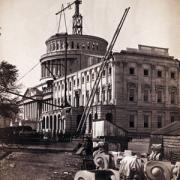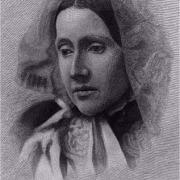Wedded to War Historic Sites of Washington City
Last month I shared with you five historic sites of New York City that appear in my Civil war novel Wedded to War. Today, I want to take you to Washington, DC--or Washington City, as it was commonly referred to in 1861. There are many sites not on this list simply because the buildings no longer exist. My goal is to show you places both "then" and "now" that you can actually visit today. First, to give you a general idea, here's what Charlotte Waverly and her sister Alice Carlisle saw upon arriving from New York City:
"The tour of the capital was disappointing, if not downright depressing. The 'city of magnificent distances' sprawled out in every direction, with long stretches of shanties, taverns, and vacant lots between a few marble buildings looking wholly out of place in the swampy city: the Capitol, the General Post Office, the Patent Office, the Treasury, the Executive Mansion, and the Smithsonian Institution. . . . Fish and oyster peddlers cried out from the corners, hawking their wares, while flocks of geese waddled on Pennsylvania Avenue and hogs of every size and color wallowed in the mud from Capitol Hill to Judiciary Square. In some neighborhoods, people still emptied slop and refuse into the gutters, and dead animals into the city canals." ~Wedded to War
Now let's zoom in.
1) The Capitol
"The Capitol building was unimpressive, a blunted, unfinished dome holding up the skeletal frame with a metal crane perched on top. Even the marble wings on the old sandstone Capitol building were so new they had no steps yet. Littering the grounds were columns, blocks of marble, keystones, carvings, lumber and iron plates, workmen's sheds, and depots for coal and wood. Rather than a stately symbol of a proud and steady country, it looked instead like an ambitious plan still under construction but with no certainty that any sense of order would ever prevail. Perhaps it was a fitting symbol of the nation, after all." ~Wedded to War
Not everything in the above excerpt is visible in the old photo, taken in March 1861 during Lincoln's inauguration, but hopefully your imagination can help fill in the blanks.
[[{"type":"media", "view_mode":"media_large", "fid":"720", "attributes":{"class":"media-image aligncenter size-full wp-image-674", "typeof":"foaf:Image", "style":"", "width":"300", "height":"341", "title":"uscapitol", "alt":""}}]]The photo at left was taken May 15, 1861, and gives a better view of the construction materials lying around. By this time, more than 3000 soldiers were quartered in the House chamber. All work on the building was halted that day, and the iron contractors were told that they would not be paid until the country’s financial outlook improved. With more than 1.3 million pounds of iron stockpiled on the site, the contractors, Janes, Fowler & Kirtland continued the work without pay.
More soldiers arrived every day during the spring and summer of 1861. Not only did they need places to sleep, but food, as well. One hundred fifty bakers worked around the clock in the cellars under the Capitol's west wing to bake 60,000 loaves daily. They were taken by wagon to the army camps encircling the city.
Of course the Capitol has come a long way since then. No visit to Washington would be complete without a stop here. The Visitor Center is open Mondays through Saturdays, but you would need to book a tour of the building in advance. Directions are here.
Frederick Law Olmsted, landscape architect of Central Park and executive secretary of the U.S. Sanitary Commission from 1861-1863, later returned to Washington City and designed the Capitol Hill grounds.
2) The Washington Monument
Though the cornerstone of the Washington Monument had been laid July 4, 1848 (the close of the Mexican War), chronic shortages of funds abbreviated its growth until, by 1861, this stump was all but abandoned. The sheds you see in the photo above housed stone gifts intended for interior walls.
This place became known as the Beef Depot, since beginning in May 1861, a large herd of cattle was brought here to graze while awaiting slaughter to feed the Union army. It was a pubilc nuisance which continued throughout the war. Walt Whitman complained of the ten thousand cows here.
Other uses for this space included billeting transient troops, training grounds for cavalry and infantry, and occasional testing of new weapons.
Today, at 555 feet tall, it is the dominant feature of Washington, D.C.'s skyline.
The difference in shading on the monument we see today marks the line where construction stopped. The capstone was finally placed in 1884.
Visit the National Park Service's Web site for the monument here. It is near the center of the National Mall. Find directions here.
Also on the National Mall (which was not called that yet in 1861) was the Armory Square Hospital, where Charlotte Waverly nursed after the second Battle of Bull Run. It was built according to U.S. Sanitary Commission recommendations and had one thousand beds in twelve pavilions. Here's an illustration of it below, made in 1864, hence the finished Capitol Dome.
3) The White House
Wedded to War's only scene in the White House takes place on Monday, Feb. 24, 1862. . .
"The huge gilt mirrors in the East Room of the White House were draped in mourning, black fabric covering the frames, and white on the glass. Grief hung so thickly in the air Edward Goodrich felt as if he was choking on it. He had never been to a child's funeral before, and he'd never dreamed that his first one would be for President Lincoln's boy. But four days ago, in this very mansion, typhoid fever had claimed the life of eleven-year-old Williw. The entire nation mourned the loss, and Edward had a front row seat to the gut-wrenching grief of a parent burying his child." ~Wedded to War
The East Room during Lincoln’s administration (pictured above) had wall-to-wall red and blue floral carpeting, wallpaper with gold highlights, massive glass chandeliers, tall golden mirrors, and a long rectangular table for dinner parties. It was the most impressive room in the White House. Mary Lincoln was too overwrought to attend her son's funeral, and wept in her rooms upstairs instead.
Visit The White House Historical Society Web site for a wealth of information.
To schedule a tour of the White House, you must submit a request through your Congressperson, up to six months in advance, and not less than 21 days in advance. See details here. For the rest of us, there is a virtual tour here.
Incidentally, the White House grounds shown above were designed by Frederick Law Olmsted's son, Frederick Law Olmsted, Jr.
4) Treasury Building
Lady clerks leaving the Treasury Building
In April 1861, Gen. Winfield Scott, then commander of the small Union army, decided the Treasury Building would be the city's last holdout in the event of an attack, protecting the President and Cabinet. This plan was never used. The Treasury Building also housed the small office of the U.S. Sanitary Commission, where Frederick Law Olmsted wrote his reports and recommendations for the army camps in and around Washington. Elsewhere in the building, supplies of the Commission were kept. Below we see the main Treasry building as it stands today at the corner of 15th and Pennsylvania Ave., NW.
Tours of the Main Treasury Building are available by advanced reservation through your Congressional offices. For more information on tours and reservations, please click here. You can also take a narrated Virtual Tour of the Main Treasury Building.
5) Pensylvania Avenue
Many historic addresses make their home on Pennsylvania Ave., including the White House and the Treasury Building. Imagine this road as it was on the morning of July 22, 1861--it was raining, muddy, and full of mobs of Union soldiers retreating after a shocking (at least to them) defeat at Bull Run. On this street, the Sanitary Commission set up tables to feed them and waited for ambulances to bring in their wounded. Ambulances came back--empty. The wounded that couldn't walk had been left on the field. An obscure address today is 627 Pennsylvania Ave., but back in the Civil War, it was the home of Matthew Brady's National Photographic Art Gallery. Matthew Brady was the world's first war photgrapher of note, considered by many the father of photojournalism. He took portraits of key figures in the war, and was on the fields at Bull Run, Antietam, Gettysburg, Fredericksburg, and more. If you want to see his work, have fun browsing the National Archives' Flickr collection. There are thousands here.
6) New York Avenue Presbyterian Church
Though we don't see New York Ave. Presbyterian Church in Wedded to War, we do meet its pastor, Dr. Phineas Gurley, and heard him preach at the funeral of Willie Lincoln in the East Room of the White House. You may find the full text of that sermon here.
In July 1862 the Army was in dire need of more hospital space. Dr. Gurley, as pastor, announced one morning that services would be suspended indefinitely since the building was needed for the wounded. According to Mr. Lincoln's City by Richard M. Lee:
On hearing this, President Lincoln stood up in his pew, interrupting, "Dr. Gurley, this action was taken withouth my consent, and I hereby countermand the order. The churches are needed as never before for divine services."
This was the Lincoln family's church throughout the Civil War. The Lincolns rented a particular pew, which was a customary means of supporting a church at that time. The "Lincoln pew" remains in approximately the same place it was in the 1860s. Visitors are allowed to sit in it, and any time a U.S. president attends, he and his family are seated in the Lincoln pew.
For more information on this historic church, including photos of the Lincoln pew, and the Lincoln stained glass window, visit here. The address is 1313 New York Ave. NW.
7) St. John's Church
"St. John's Church was emptier than usual today, and the conspicuous gaps in the high-backed pews distracted Charlotte from the sermon. Outside, the steady sound of carriages, gigs, hacks, and wagons rolling by was like one continuous low roll of thunder, punctuated by riders' laughter and son, and by champagne bottles clinking at their feet." ~ Wedded to War
In the excerpt above, the congregation in St. John's Church heard the sounds of people skipping church to go picnic-ing on the battlefield near Manassas, Virginia, twenty-five miles west of Washington City, for a glimpse of the battle of Bull Run. It was July 21, 1861. After the church service, Gen. Winfield Scott shook hands with those who were there, then went home to take his afternoon nap, having no clue the disaster that was about to befall the Union army.
St. John's Church on Lafayette Square is one of the most historic buildings of the city, and its appearance is unchanged since the Civil War--which is great for me, since I couldn't find a photo earlier than 1918 anyway. :) Known as the Church of the Presidents, James Madison and several early presidents after him were communicants, as were more recent chief executives.
The bell in St. John's steeple was cast by Paul Revere's son, Joseph, at his Boston foundry in August 1822 and installed at St. John's on November 30, 1822. St. John's bell is one of two Revere bells in Washington, both cast and installed in 1822. However, of the two, St. John's bell is the only one that has been in continuous service since its installation.
Find location and directions here.
The church is open daily and is free to enter. Tours of the church are available on a regular basis following the 11:00 a.m. service (10:30 a.m. during the summer) on most Sundays. Special tours may be arranged by contacting the church office at 202.347.8766.
8 ) Willard's Hotel
Willard's Hotel
While Frederick Law Olmsted worked out of his office in the Treasury Building for the Sanitary Commission, he stayed in Willard's Hotel. Before the Lincolns moved into the White House, they stayed here. During the war, Willard's Hotel was known as the gathering place for Union supporters, and the heart of the Union, even more so than the Capitol building. Its bars, sitting rooms, corridors and dining rooms were full of lobbyists, politicians, contractors, officers, financiers, war correspondens, and anyone else who wished to learn anything or have any influence over the fate of the Union. It was in the lobby of the Willard Hotel that Ulysses S. Grant popularized the term "lobbyist."
But more than just deals and handshakes took place here. On Nov. 19, 1861, Julia Ward Howe spent the night here, and in the predawn hours, awoke with lyrics running through her mind. Hastily, she wrote them down, to the tune of John Brown's Body, and went back to bed. She had just written the "Battle Hymn of the Republic," which would become the rallying cry of the Northern army. In Wedded to War, while working in a field hospital on the Virginia peninsula, Charlote and other women sang this hymn to boost morale--and to drown out the drone of the wounded. Charlotte Waverly and Alice Carlise (my fictional characters) were staying across the street at the Ebbitt House when Julia Ward Howe was at Willard's.
As a side note, the Ebbitt House is no longer in existence, but here is what it looked like:
Original Ebbitt House
For more history on the Ebbitt House, click here. Now back to Willard's. There is now an exlusive, luxury hotel at 1401 Pennsylvania Ave., called simply The Willard Washington DC. Directions and a photo gallery of the interior are here.
The Willard
This concludes the Wedded to War Historic Sites of Washington City tour! If I find more, I’ll add them. But my next project will be the Wedded to War Historic Sites of Virginia! Wondering what Wedded to War is all about? Click here for an overview and book trailer.


